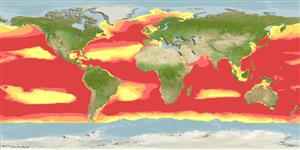分类 / Names
俗名 | 同种异名 | Catalog of Fishes(属, 种) | ITIS | CoL | WoRMS | Cloffa
Teleostei >
Aulopiformes (Grinners) >
Alepisauridae (Lancetfishes)
Etymology: Alepisaurus: Greek, alepis, -idos = without scales + Greek, sauros = lizard (Ref. 45335); ferox: The specific name is derived from ferox, meaning ferocious (Ref. 6885).
More on author: Lowe.
Environment: milieu / climate zone / depth range / distribution range
生态学
海洋 深海区的; 海洋洄游的 (Ref. 51887); 深度上下限 0 - 1830 m (Ref. 50550). 深水域; 84°N - 57°S, 180°W - 180°E
Circumglobal: Western Pacific (Ref. 6885, 7300); Eastern Pacific: from the Aleutian Islands to Chile, also (Ref. 2850); Western Atlantic: Gulf of Maine to the Gulf of Mexico and the Caribbean Sea, also (Ref. 7251); Eastern Atlantic (Ref. 4059). Indian Ocean (Ref. 57630). Northwest Atlantic: Canada (Ref. 5951). South China Sea and East China Sea (Ref. 74511).
Curcumglobal: 西太平洋;(参考文献 6885,7300) 东太平洋;(参考文献 2850) 西大西洋;(参考文献 7251) 东大西洋.(参考文献 4059) 印度洋.(参考文献 57630)
大小 / 重量 / 年龄
Maturity: Lm ? range ? - ? cm
Max length : 215 cm TL 雄鱼/尚未辨别雌雄; (Ref. 7251); common length : 150 cm TL 雄鱼/尚未辨别雌雄; (Ref. 5217); 最大体重: 9.0 kg (Ref. 42154)
背棘 (总数) : 0; 背的软条 (总数) : 30 - 45; 臀棘: 0; 臀鳍软条: 13 - 18; 脊椎骨: 47 - 52. Mouth large with two erect fangs on palatines. Dorsal fin very high, about three rays beginning with third or fourth much exerted; adipose moderate in size, over posterior part of anal insertion (Ref. 6885). Generally pale, iridescent, darker dorsally; lateral adipose keel dark; all fins dark brown or black; peritoneum black (Ref. 6885). Branchiostegal rays: 7-8 (Ref. 36025).
在颚骨上嘴巴大的,有二个直立的尖牙。 背鳍很高的, 大约三鳍条开始用第三或第四个很多发挥; 脂肪的中等在大小方面, 在臀鳍嵌入点的较后面的部分之上.(参考文献 6885) 通常灰白的,彩虹色的,和比较黑的背面; 侧面的脂肪龙骨脊黑的; 所有的鳍深褐色或黑色的; 腹膜黑色.(参考文献 6885) 鳃条骨: 7-8.(参考文献 36025)
Mainly inhabit tropical and subtropical waters; however, during the feeding period adults may migrate to the subarctic reaching as far north as Greenland, Iceland and the Bering Sea (Ref. 51887). Epipelagic- and mesopelagic, from near the surface to below 1,000 m, sometimes approaching inshore waters (Ref. 6011). Bathypelagic (Ref. 58302). Mainly nocturnal. Feeds on fishes, cephalopods, tunicates, and crustaceans (Ref. 6011). Preyed upon by opah, sharks, albacore, yellowfin tuna, and fur seals (Ref. 6885). Oviparous, with planktonic larvae (Ref. 36025). Are synchronous hermaphrodites (Ref. 84733). Occasionally consumed but of little importance due to its soft flesh (Ref. 5217). The maximum weight given is for a 167 cm FL specimen (Ref. 42154).
主要栖息于热带与亚热带的水域; 然而, 在摄取食物的期间成鱼可能回游到靠近北极的达到向北远至格陵兰,冰岛与白令海.(参考文献 51887) 表层带- 而且中层带, 从接近水表面到在 1,000 公尺之下, 有时接近近岸水域.(参考文献 6011) 主要夜行。 捕食鱼,头足类动物,被囊类与甲壳动物。 (参考文献 6011) 被青花鱼,鲨鱼,巴鲣鱼,黄鳍鲔鱼与皮毛海豹捕食了。 (参考文献 6885) 卵生的, 仔鱼为浮游性.(参考文献 36025) 偶然地消费了但是重要性很小由于它的软肉.(参考文献 5217)
Life cycle and mating behavior
成熟度 | 繁殖 | 产卵场 | 卵 | 孕卵数 | 仔鱼
Oviparous. Gonads of adolescents are hermaphroditic, but there is no proof that the species is a functional hermaphrodite (Ref. 6011). However, further studies show that this species is a synchronous hermaphrodite where gonads consist of clearly defined and well separated ovarian and testicular regions with no indication of sequential maturation of the sex products (Ref. 84733).Curcumglobal: 西太平洋;(参考文献 6885,7300) 东太平洋;(参考文献 2850) 西大西洋;(参考文献 7251) 东大西洋.(参考文献 4059) 印度洋.(参考文献 57630)
Post, A., 1984. Alepisauridae. p. 494-495. In P.J.P. Whitehead, M.-L. Bauchot, J.-C. Hureau, J. Nielsen and E. Tortonese (eds.) Fishes of the north-eastern Atlantic and the Mediterranean. UNESCO, Paris. Vol. 1. (Ref. 6011)
世界自然保护联盟红皮书 (Ref. 130435: Version 2024-2)
人类利用
渔业: 商业性
工具
特别资料
下载 XML
网络资源
Estimates based on models
Preferred temperature (Ref.
123201): 4.7 - 14.6, mean 8.9 °C (based on 1772 cells).
Phylogenetic diversity index (Ref.
82804): PD
50 = 1.0000 [Uniqueness, from 0.5 = low to 2.0 = high].
Bayesian length-weight: a=0.00389 (0.00180 - 0.00842), b=3.12 (2.94 - 3.30), in cm total length, based on all LWR estimates for this body shape (Ref.
93245).
营养阶层 (Ref.
69278): 4.0 ±0.2 se; based on diet studies.
Fishing Vulnerability (Ref.
59153): Very high vulnerability (90 of 100).
Nutrients (Ref.
124155): Calcium = 13 [4, 37] mg/100g; Iron = 0.292 [0.097, 0.916] mg/100g; Protein = 16.3 [13.1, 18.8] %; Omega3 = 0.0817 [, ] g/100g; Selenium = 33.6 [10.2, 94.9] μg/100g; VitaminA = 7.96 [0.91, 66.44] μg/100g; Zinc = 0.284 [0.147, 0.569] mg/100g (wet weight);
